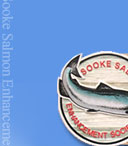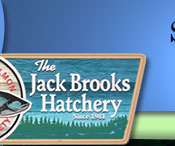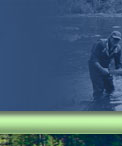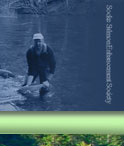The very existence of the Sooke Salmon Enhancement Society and the sustainability of local salmon is a tribute to the single-minded vision and tenacity of the late Jack Brooks. Moving to Sooke in the early 50’s as a FishWarden with the Department of Fisheries and Oceans, he came to the area when commercial fishing was the life-blood of the community and the fishers and fish trap operators were an economic mainstay of Sooke.
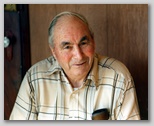
Jack Brooks 1909 - 2001
Jack Brooks observed the decline in local fishing stocks and realized that the fishery that everyone took for granted could disappear. He was relentless in pursuing poachers and polluters and did not make himself popular at a time when many did not take fishing licenses or quotas seriously. He began on his own to salvage Coho fry from creeks that were drying-up in the summer and would release the fry in the water of the upper Sooke River – above the potholes. In 1954 he persuaded DFO to construct the fish trap and dam on DeMamiel Creek beside Young Lake that the Sooke Salmon Enhancement Society continues to maintain and operate. Gradually he started to recruit teenagers and local commercial fishers to his efforts. The volunteers were known as the Sooke Conservation Society.
By 1966 efforts had turned to hatching salmon in homemade gravel boxes that were set in Mary Vine Creek. Three of the early volunteers assisting Jack Brooks were Pat Forest, Bill Pedneault and Mel Hull and they continue to this day as volunteers in the Society. In the early days there was much experimentation in fish hatching and the volunteers gradually discovered ways to reduce mortality rates in young salmon. After hatching the alevin were carried by vehicles in five-gallon pails to be released in the upper Sooke River as well as DeMamiel, Kirby, Tugwell, Ayum, Muir and Rocky Creeks.
In 1981 the hatchery began operations at a location on Rocky Creek – just above the confluence of DeMamiel and Rocky Creeks. With Capilano troughs that had been discarded by other hatcheries or purchased from donations, the volunteers - now incorporated as the Sooke Salmon Enhancement Society - were able to raise fish to fry size that would have a head start on their release to the wild. The hatchery was of course named the Jack Brooks Hatchery

in recognition of the man who had inspired the efforts of volunteers and contributors. Trevor Morris another DFO employee also came to the aid of the Society and through his efforts they obtained commercial hatching trays from the Sechelt First Nation.
In the early 1990’s a pump house was constructed below the hatchery to ensure a supply of water in summer months when water levels drop in Rocky Creek.
While the hatchery has supported the enhancement of Coho, Chinook, and Steelhead, primary efforts today are in Chinook production and secondarily Coho. By the 1980’s Chinook had virtually disappeared from the Sooke River and it became necessary to import Nitnat stock to revive the hatchery. Today wild Chinook spawn in great numbers in the Sooke River and wild Coho numbers in the Sooke and its tributaries are far beyond the numbers found in similar sized creeks on the Island. While times and technology have all but ended commercial fishing in Sooke, the community continues to be a premier location for sports fishing for Pacific Salmon. As the volunteers say, “We hatch them. You catch them.”
Now, with the new location and recent construction of the new hatchery, it is now known as the Sooke River Jack Brooks Hatchery.
The New Sooke River Jack Brooks Hatchery

We are very excited to announce that our most recent and biggest project is the $1.5 million salmon hatchery which is up and running! The Sooke River Jack Brooks Hatchery, as it is now known, has been built on land leased by the Juan de Fuca Salmon Restoration Society on Sooke River Road where they own and operate the Charters River Interpretive Centre. In addition, the Capital Regional District has agreed to grant us a continuing water supply to the new location.
The Jack Brooks Hatchery which began operating in 1981 on Rocky Creek had been seeing declining water levels for several years, and that meant that the salmon fry had to be released earlier than desired, making them smaller than ideal. Because of the location of the former hatchery and the shortage of water, we could not hold the quantities of fry (up to 500,000) to the optimum release size. Now with the constant flow of water, we’ll be able to raise that 500,000 to ideal release size. On average, 500 Chinook return to the Sooke River, and now, because of the new hatchery location, hope is that we can build the returns in the coming years.
Construction at the new site was made possible by the Pacific Salmon Foundation and tremendous support from the Juan de Fuca Salmon Restoration Society, local businesses, the tireless work of volunteers and the generosity of many people who have donated, and continue to donate, to the project.
This is about saving salmon, Coho as well as Chinook. When we help the salmon, we help the southern resident killer whale population, commercial fishermen, recreational fishermen, the First Nation’s Fishery and the environment.
